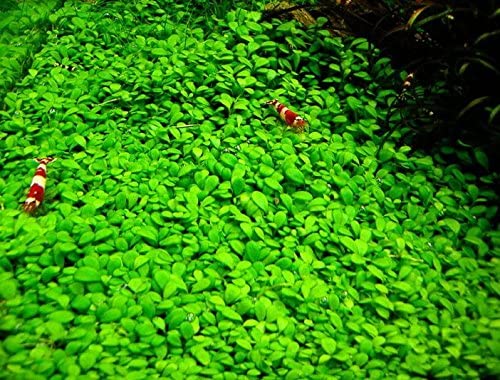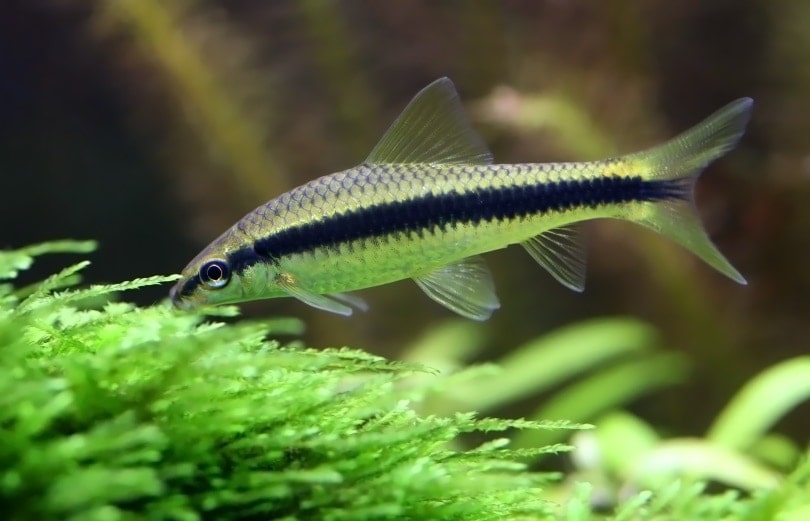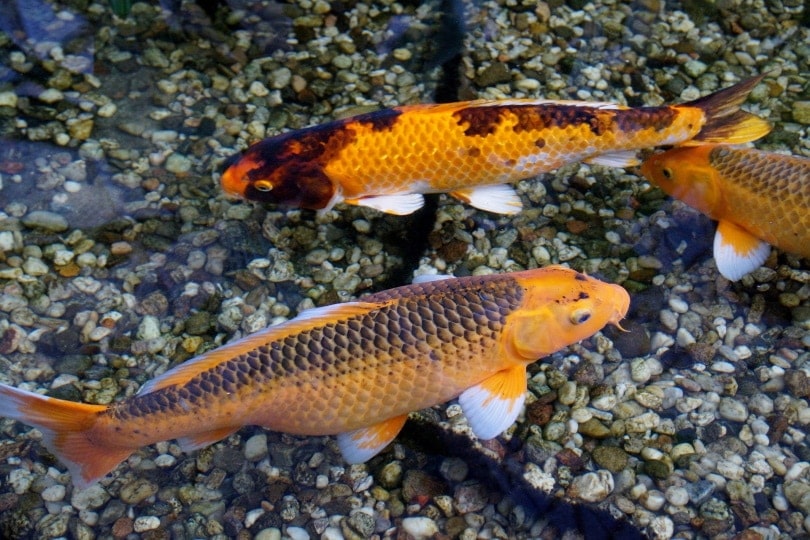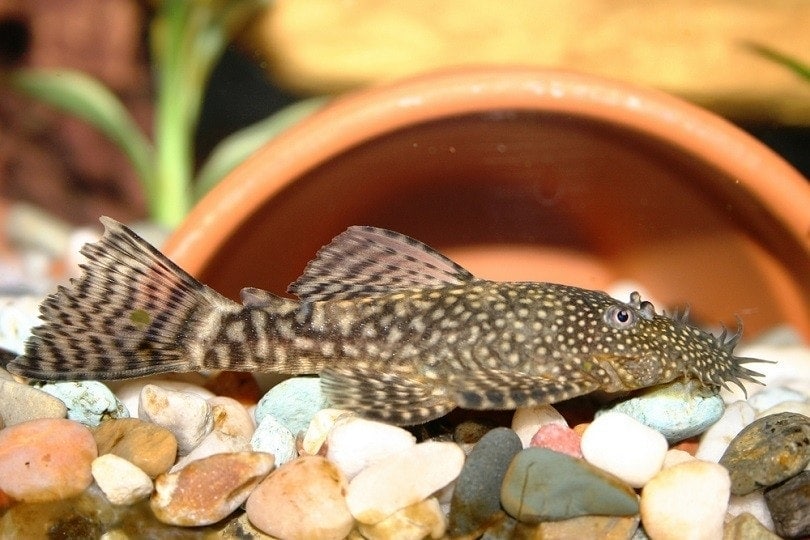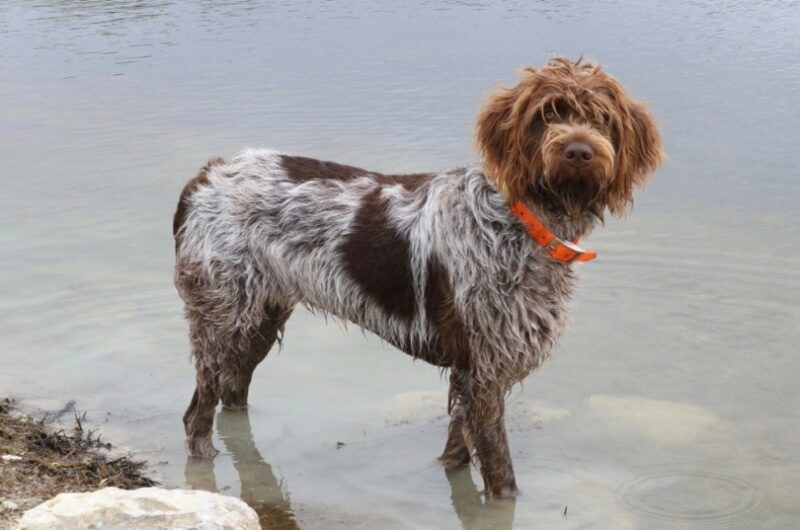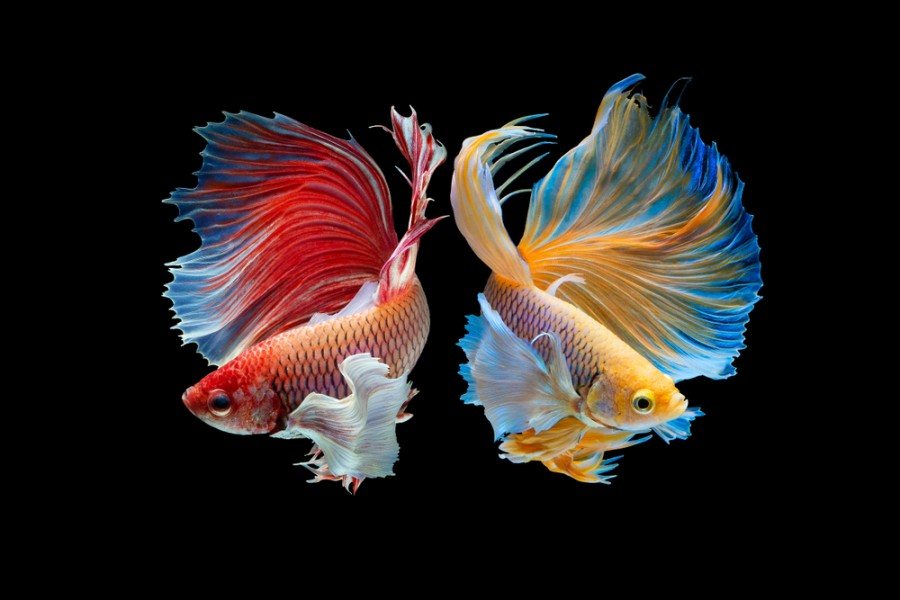10 Best Aquarium Carpet Plants & Grasses in 2024 – Reviews & Top Picks

Updated on
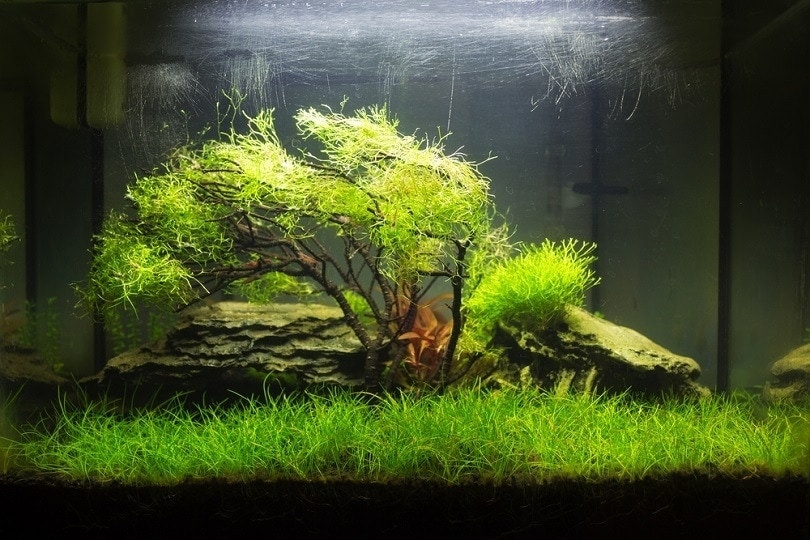
If you have recently purchased an aquarium or looking to improve the one you have been using, you may want to know about the different types of plants you can install. Carpet plants and grasses spread out and create a covering over the tank floor, and there are several types you can try to achieve the appearance you want.
We’ve chosen ten of the most popular types to discuss with you in more detail. We’ll go over how easy they are to grow and how much maintenance they require. We’ve also included a short buyer’s guide where we talk about how to grow these plants and what equipment you need.
Join us while we talk about lighting, CO2, plant size, propagation, and more to help you make an educated purchase.
A Quick Comparison of Our Favorites of 2024
| Rating | Image | Product | Details | |
|---|---|---|---|---|
| Best Overall |

|
Christmas Moss |
|
Check Price |
| Best for the Money |

|
Dwarf Hairgrass |
|
Check Price |
| Premium Pick |

|
Dwarf Baby Tears |
|
Check Price |

|
Monte Carlo |
|
Check Price | |

|
Utricularia Graminifolia |
|
Check Price |
The 10 Best Aquarium Carpet Plants and Grasses
1. Christmas Moss – Best Overall
| Growth rate: | Fast |
| Max height: | 4 inches |
| Light demands: | Medium |
| CO2: | Low |
| Difficulty: | Easy |
When it comes to keeping carpeting and grassy aquatic plants, there are not many options easier than mosses. Christmas moss is our top pick because of its easy care level, as well as its beauty. This plant can be grown on just about any natural surface, from gravel and stone to driftwood. You can tie or superglue it into place, allowing it time to properly root.
Once rooted, Christmas moss will quickly begin to spread. While CO2 and liquid fertilizer will enhance the growth of Christmas moss, it doesn’t require any special care. It’s also easy to propagate, so you’ll have enough to cover your tank in only a few weeks or months, depending on the care. The brighter the lighting, the faster the growth will be.
- Easy to care for
- Unique and beautiful
- Can be attached to most surfaces
- No special care is needed
- Easy to propagate
- Grows fastest in bright lighting
2. Dwarf Hairgrass – Best for the Money
| Growth rate: | Fast |
| Max height: | 4 inches |
| Light demands: | Moderate |
| CO2: | Low |
| Difficulty: | Easy |
Dwarf hairgrass is an excellent pick if you’re looking for an easy-care grass for your aquarium. This plant can thrive in water temperatures anywhere between 50–85°F, making it suitable for a variety of freshwater tanks, although it does best with a neutral pH level. It also can tolerate just about any water flow, from standing water to swift movement. It does require moderate lighting to grow quickly and thrive, but it can grow well without CO2 and fertilizers. It stays small and, while it does spread very quickly, it can also be pruned and kept under control, making this a great pick for nano tanks.
- Easy to care for
- Wide temperature range
- Tolerates any type of water movement
- Grows well without special care
- Easy to prune
- Prefers neutral pH
- Requires moderate lighting
3. Dwarf Baby Tears – Premium Pick
| Growth rate: | Fast |
| Max height: | 6 inches |
| Light demands: | High |
| CO2: | High |
| Difficulty: | Moderate |
If you’re looking for a carpet plant with a delicate appearance, then dwarf baby tears is a nice pick for you. This is a moderate-care plant, requiring high light levels and added nutrients. The payoff of the care of this plant is worth it, though. With proper care dwarf baby tears will even put out small flowers. It’s ideal for nano tanks and is easy to prune.
This plant can be grown in substrate, on surfaces, or even floating, giving you plenty of options for it. It should be grown in tanks with moderate to high water flow, and because it’s a tropical plant, it thrives in warm water tanks.
- Unique, delicate appearance
- Will flower with proper care
- Ideal for nano tanks
- Easy to prune
- Can be grown in multiple ways
- Requires high lighting and nutrients
- Needs moderate to high water flow
- Need tropical temperatures
4. Monte Carlo
| Growth rate: | Moderate |
| Max height: | 2 inches |
| Light demands: | High |
| CO2: | Low |
| Difficulty: | Moderate |
Monte Carlo is an excellent aquarium plant to fill the foreground of your tank or carpet the whole substrate. With proper care, it grows thick and spreads quickly, but it does require CO2 injection and high lighting levels to thrive and spread. It should be pruned regularly when growing well to keep it from taking over the tank. For people struggling to succeed in growing dwarf baby tears, Monte Carlo is a great substitute. Monte Carlo can be grown submerged or immersed, making it suitable for aquariums and Wabi Kusa setups.
- Good foreground plant
- Moderate to fast growth rate
- Good alternative to dwarf baby tears
- Can be grown emersed or submerged
- Requires CO2 and high lighting levels
- Should be pruned regularly
5. Utricularia Graminifolia
| Growth rate: | Fast |
| Max height: | 10 inches |
| Light demands: | Low |
| CO2: | Medium |
| Difficulty: | Moderate |
Utricularia is more than a great foreground plant for your aquarium, it’s also a carnivorous plant. While it’s extremely unlikely to predate anything you intentionally put in your tank, it does a wonderful job of consuming infusoria and very small things living in the water column and substrate. In many cases, it will need to be fed to maintain its health and growth, and CO2 is recommended. It thrives in soft, acidic, nutrient-poor water, making it ideal for blackwater setups. It requires low lighting while becoming established, but after 6–8 weeks, the lighting should be increased to moderate to high.
- Good foreground plant
- Reduces some unwanted creatures in the tank
- Thrives in blackwater environments
- Can survive in low to high lighting
- May need to be fed
- CO2 is recommended
6. Pogostemon Helferi
- Growth rate: Moderate
- Max height: 6 inches
- Light demands: Low to medium
- CO2: Required
- Difficulty: Beginner
Pogostemon Helferi is a perfect foreground plant that often has a star-shaped appearance. It can grow up to 6 inches but usually stays at 4 or less. It provides a great hiding place for your fish and other animals, and its quick-growing roots allow it to attach itself soon after moving it. The package we received was well packaged and had no snails.
You will need to provide CO2 when growing the Pogostemon Helferi, so make sure you have a system in place before ordering your plants.
- Quick growing roots
- No snails
- Requires CO2
7. Riccia Fluitans
- Growth rate: Moderate
- Max height: 2 inches
- Light demands: Low
- CO2: Low
- Difficulty: Beginner
Riccia Fluitans is sometimes called Crystalwort. It’s a floating plant but grows well when submerged, and many people use it as a carpet for their aquarium by tying it to a rock or other stable surface until it gets rooted. It’s easy to grow and requires very little maintenance once it gets started. It doesn’t require CO2, but it can help the plants grow faster if you have the system. This best fast-growing aquarium carpet plant is also suited to low light conditions, and our package arrived with a guarantee that the plants would live for seven days.
The primary downside to Riccia Fluitans is that you only get a small portion, and the shipping process is too rough for these delicate plants, and they often arrived damaged or dried out. The customer service sticks by the seven-day guarantee, but it can get frustrating if you are a repeat customer.
- 7-day guarantee
- Low maintenance
- Small portion
- Easily damaged when shipping
8. Helanthium Tenellum
- Growth rate: Slow
- Max height: 8 inches
- Light demands: Strong
- CO2: Required
- Difficulty: Easy
Helanthium Tenellum is another grass type carpet plant that covers the ground via long runners. If it grows too quickly or becomes too dense, you can cut the runners to slow growth. It’s easy to maintain and can get as tall as 8 inches making it suitable for the entire tank. It provides a perfect hiding spot for shy or breeding fish and it won’t overtake the other plants.
The downside to the Helanthium Tenellum is that it will grow very slowly unless you supply a good amount of light and CO2.
- Ground covering
- Easy to maintain
- Requires strong lighting
- Requires CO2
9. Java Moss
- Growth rate: Moderate
- Max height: 4 inches
- Light demands: Low
- CO2: None
- Difficulty: Beginner
Java Moss is one of the most popular mosses found in home aquariums because it is extremely easy to grow. It doesn’t require extra light or CO2, but you can add them if you want the moss to grow quickly. This brand contains three rocks with the moss, so all you need to do is drop them into your tank. If you want the moss to spread and create a bed, add CO2. Otherwise, your java moss will require next to no maintenance.
The downside to java moss is that without additional CO2, the moss will grow slowly, and you may not notice a difference after several months, which can cause some owners to become impatient.
- Three pack
- Low maintenance
- Very slow growing
10. Glossostigma Elatinoides
- Growth rate: Fast
- Max height: 1 inch
- Light demands: High
- CO2: Required
- Difficulty: Moderate
Glossostigma Elatinoides is a fast-growing aquatic plant that only grows about one-inch tall and is perfect for the tank’s front. Its rapid advancement can be exciting to watch, and it created a plush carpet and will help clean the water.
Glossostigma Elatinoides is the only carpeting plant on this list with a moderate difficulty rating. It’s higher rating is due to the high amount of light and CO2 they require to grow correctly, but once you have the correct levels established, they will need very little maintenance.
- Fast-growing
- Perfect for the foreground
- It helps clean the water
- Requires plenty of light
- Requires plenty of CO2
Buyer’s Guide: Choosing the Best Aquarium Carpet Plants & Grasses
Let’s look at some important things to consider before you purchase your next aquarium carpet plant.
Propagation
Propagation refers to how fast the plant spreads. Some plants spread on their own through runners that branch off the parent plant and sprout new ones. However, most others will require you to prune the plant with long sharp scissors and planting the cuttings. You can prune faster-growing plants more often, and it will be easier to create a complete ground covering. However, if you are looking for an accenting plant, you will want something slower growing.
Height
The next thing you will want to think about when choosing a carpet plant for your aquarium is how tall the plant will be when fully grown. Shorter plants are perfect for the tank’s front and are great for attaching to driftwood and other items in the tank. Keep your foreground plants under 4 inches.
Plants taller than four inches are best suited to the back of the tank, where they will not obstruct your view. These plants are attractive and provide a fantastic hiding place for shy fish and for those that are breeding.
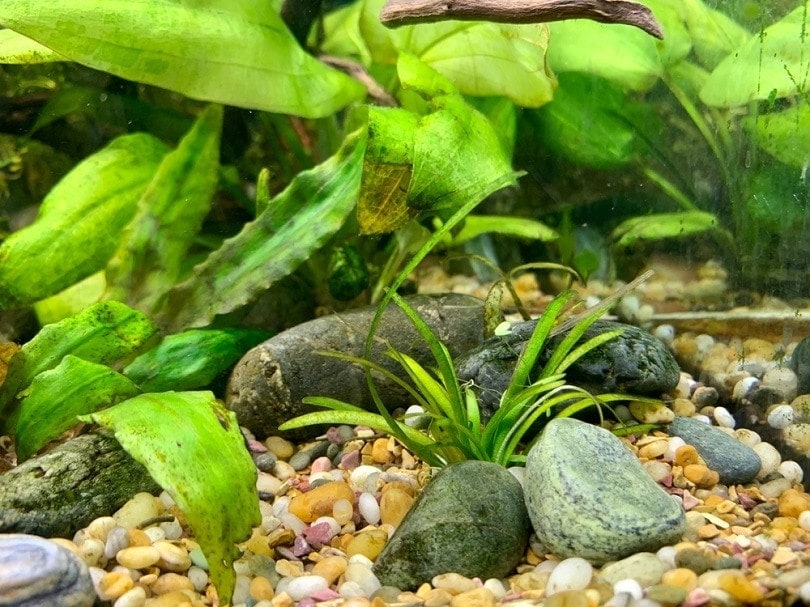
Light Demands
Many plants will not require additional lighting but some will. With the increasing popularity of LED systems replacing the traditional bulb that requires plenty of electricity and frequent changes, adding more light to your aquarium is inexpensive and long-lasting. These LED systems can provide your plants with the full spectrum of light your plants require to grow.
CO2
Many plants will require carbon dioxide for optimal growth. Even those that don’t need it will benefit from adding it to the tank and will often grow faster and taller. However, adding CO2 to the tank requires an entire system, and the knowledge to use it. In most cases, you can buy the whole kit online or from a pet store. You will need a tank of gas, a CO2 regulator, a bubble counter, and tubing. Often purchasing the whole kit will supply you with the instructions for installing it.
Difficulty
All of the plants we chose to include on this list are easy to maintain and require little effort to keep them alive. However, many other varieties are much more challenging. If you are inexperienced, we highly recommend choosing one or two of these varieties first to gain the experience you need.
Conclusion
Carpeting plants and grasses are ideal additions to many aquarium setups, especially if you’re looking for a foreground plant. Our best overall pick is Christmas moss, which is easy to grow, can be grown on a variety of surfaces, and spreads quickly. We also like dwarf hairgrass, which grows and spreads quickly, as well as being easy to prune, and dwarf baby tears, which is a delicate and uniquely beautiful plant that grows quickly with proper care, sometimes even producing small flowers. Of course, whatever plants you select should fit with the parameters of your tank, so thoroughly research any plant before attempting to grow it, which is what these reviews are for!
Featured image credit: Dario995, Shutterstock













